Miletus
Q169460Miletus: (Μίλητος): one of the main Greek cities in Ionia.
Early History

Miletus is already mentioned in Hittite sources, which call the site Millawanda and state that it belonged to a political unit called Ahhiyawa, which is probably the kingdom of the Achaeans, although this identification is not uncontested. Archaeologists, digging in the area of the archaic temple of Athena, have distinguished three occupation phases:
- a Minoan settlement,
- a Mycenaean town founded in the second half of the fifteenth century and destroyed at the turn of the third and fourth quarter of the fourteenth century (captured by troops of the Hittite king Mursili II?)
- a walled Late-Mycenaean town that flourished in the thirteenth century and was destroyed in the second half of the twelfth century; the founding of this city may have been remembered in the legend told by Strabo that a man named Miletus came to Asia from Crete, together with the Homeric hero Sarpedon.note
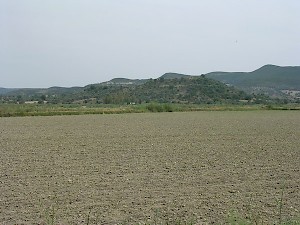
Miletus was the main Mycenaean settlement in Asia Minor. From Hittite documents, we know that in the east and north, it bordered to a kingdom named Mira, and in the south to Lukka (Lycia). In the first half of the twelfth century, Millawanda was the base of an Anatolian prince named Pijamaradu, whose aggressive policies caused sufficient concern to the king of the Hittites to send a letter to the king of Ahhijawa (the "Tawaglawa Letter").
After the fall of Millawanda, the inhabitants appear to have moved to a hill in the southwest called Kalabak Tepe. Homer reckons these people among the Carians,note and that they were indeed assimilated, or took part in a process of ethnogenesis, is confirmed by Herodotus, who says that Miletus was founded by Neileos of Athens; his men had no wives, and they married to Carian girls whose fathers the invaders had killed.note Whatever the historical truth, at the end of the Dark Ages, the city was still or again Greek.
Center of Ionia
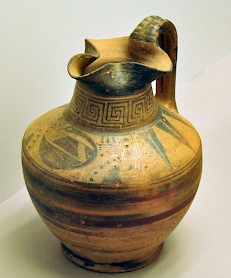
The city rapidly expanded. Finds from the eighth century have been done all over the area between Kalabak Tepe and the archaic temple of Athena, and in the sixth century, the city occupied an area that was four times as large, even northeast of the site that was - in the classical and Roman age - the port. Miletus was the unofficial capital of the Ionian Greeks. It sent out colonies, reportedly no less than seventy-five,note like Abydus in the Hellespont area, Sinope on the southern shore of the Black Sea (which in turn founded Trapezus), and Naucratis in Egypt. The city must have been wealthy, and was a logical place for the invading Cimmerians to attack.
Miletus was also a center of learning. Citizens like Thales, Anaximander, and Anaximenes invented philosophy, and Hecataeus was the founder of geography. The city was ruled by tyrants; we know the names of Thoas and Damasenor, and we know that a tyrant named Thrasybulus withstood an attack from the king of Lydia, Alyattes, and a deal was concluded that offered the city a special position within the sphere of influence of the Lydians. This deal continued during the reign of Alyattes' son and successor Croesus, and Cyrus the Great, the Persian king who subdued the Lydian empire at some point after 547 BCE.
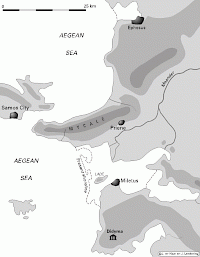
According to Herodotus of Halicarnassus, the Milesians played an important role during the Scythian campaign of Darius I the Great, in c.513. The tyrants Histiaeus and Aristagoras were rewarded and the city received, as a present, a silver mine in Thrace, which made Miletus virtually independent.
After a failed Persian expedition to conquer the islands in the Aegean Sea, the Milesians and the other Ionians revolted. However, they were defeated in the battle of Lade, and the city was captured and sacked. Many inhabitants were deported (494 BCE). Miletus was rebuilt on a gridiron plan that was named after the Milesian Hippodamus; this became the Greek and Roman standard for urban planning.
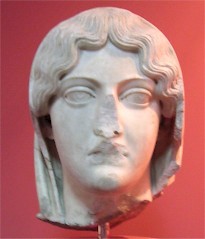
After the Persian Wars, Miletus became part of the Delian League, Athens' anti-Persian alliance, paying ten talents of silver. Somewhere in the 440s, the city tried to leave the league, but it was defeated and from then on had a garrison. For a generation, the city was a safe part of the Athenian empire, and Milesians made their way into the highest circles: one lady from Miletus, Aspasia, even married to Athens' unofficial leader, Pericles. It was only after the Athenians had decided to intervene in the affairs of the Persian Empire (the Amorges Affair), that king Darius II Nothus decided to support Athens' enemy Sparta, which created revolts in the Athenian Empire (the Ionian War), and led to the fall of Athens and the end of its league.
Miletus was one of the main rebels and had been one of the navy bases of the Spartans. However, it did not really benefit: at the beginning of the fourth century, the Persian satrap of Caria, Tissaphernes, controlled the city. Later, Hecatomnus, another satrap of Caria, ruled Miletus. During his reign, the Milesians started to build the theater that still dominates the site. The next ruler was Alexander the Great who, after his victory at the Granicus, proceeded to the south, obtained Sardes and captured both Lade and Miletus, the latter after a brief siege (334 BCE). Although the city had to pay contributions to Alexander's war chest, it was more autonomous than it had been for at least two centuries.
Hellenistic Age
It managed to retain some of its independence during the wars of the Diadochi, who were all courting the Greek cities with promises of freedom and autonomy, and had to deliver the goods somehow. However, after 300, the city was in the Seleucid zone of influence, and when the city was occupied by a condotierre named Timarchus, the Seleucid king Antiochus II felt free to intervene; the liberated Milesians awarded him the surname Theos, "the god", in 259/258.
As was common in this age, the city concluded treaties of mutual help and isopoliteia with other cities: if one settled in the city of the treaty partner, one could receive full citizen rights. These alliances (Tralles 212, Mylassa 209) helped Miletus to resist Priene, which was situated across a small gulf, and was rapidly becoming more powerful. The main alliance, however, was with Rome. After the Syrian War, when the Peace of Apamea was concluded, Miletus received back a holy district which it had had to evacuate. New alliances of isopoliteia followed (Pedasa 188, Heraclea 185), but in 133 the city became part of the province of Asia.
Roman Age
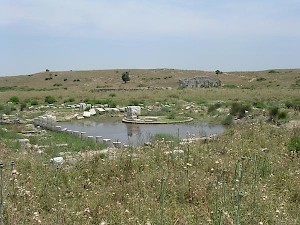
Miletus benefited from Roman sovereignty. It was from the beginning a major center for the provincial cult; there was a monument for an important naval victory - although it is not known who was defeated, the Cilician Pirates or Mark Antony. The other side, however, was that the city was attacked by any anti-Roman leader, like Mithridates VI Eupator of Pontus. Still, generally speaking, the city prospered, and it showed its gratitude by starting a new era in 17/16 BCE, at the same time of Augustus' festival of the Saeculum Novum.
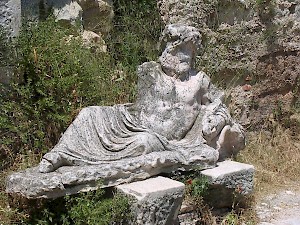
Most monuments that you can see today in Miletus date back to the Roman age, even when the buildings are originally older. Only Ephesus was a more important city in Asia Minor. Miletus continued to attract foreigners (Jews and Christians are both attested in the first century).
In 262, the city received new city walls, which surrounded more or less the entire region that had already been covered in the sixth century BCE, except for the Kalabak Tepe area. However, the harbor was silting up, the Roman economy was in decline, and the city was suffering. When the emperor Justinian rebuilt the city wall in 538, it had become a really small town, and in the seventh century, we see adaptations to a new age. The Middle Ages had begun.